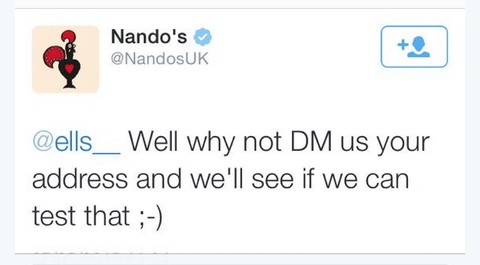Social media is great for sending personalised messaged to customers- but what happens when brands get too personal? Nando’s recently attracted criticism after a its tweets to a female customer crossed the line from friendly to creepy.
In a rather awkward Twitter exchange about the restaurant chain’s ‘hot sauce’ the chicken company asked for the home address of a female customer, much to her suprise.
Nando’s has since claimed that it was only offering to post her a bottle of the brand’s “hot sauce”, rather than volunteering to visit her house.
“We like to have fun with our customers on Twitter and reward our loyal fans,” a spokesperson told The Telegraph. “We wanted to send Elle a bottle of hot sauce in response to her tweet, which is where the reference to ‘handling the heat’ comes from.
“We would never intentionally offend someone and when we realised we may have done so, deleted the tweet. This is not something we would usually do.”
How the exchange heated up
It all started when Twitter user and Nando’s’ customer ‘Elle’ tweeted “I thought I could handle Nandos hot chicken. But boyyyy the way my mouth was burning.”
Nando;s must have name-searched, because they were not tagged in the tweet. They replied: “Can’t handle the heat Elle? ;-)”
Elle said in response: “I can handle it, I just choose not to actually.”
The restaurant chain then sent this reply, which many felt to be inappropriate: “Well why not DM us your address and we’ll see if we can test that ;-)”
The customer took a screenshot of the tweet, and sent it to her followers. Nando’s quickly deleted the tweet.
The episode is a strong reminder to brands to think before they tweet. Emoticons and Emojis might be seen as a fun and informal way for a brand to look credible to consumers, but they need to consider the context of each message.
Is nandos moving me or am I seeing things pic.twitter.com/NVY2dWWQOc
— Elle (@ells__) May 27, 2015

